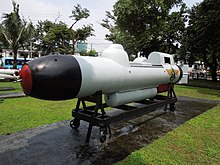Design


The craft weighs 2,100 kilograms (4,600 lb) out of water and is 7 or 8 metres (23 ft 0 in or 26 ft 3 in) long according to type. It resembles a torpedo but has two cockpits for the crew. Some models have a roof with sliding doors for the cockpits. In some models the rear cockpit is long and can seat two divers for a total crew of three. Its battery-electric motors gives it a submerged range of 50 nautical miles (93 km; 58 mi) at 4 knots (7.4 km/h; 4.6 mph), the maximum speed being 5 knots (9.3 km/h; 5.8 mph). For long distance it generally reaches the operating area either attached to or towed by another vessel. A belly-pan beneath its hull can carry special equipment, or 230 kg (510 lb) of heavy explosive charges, or 150 kg (330 lb) of limpet mines, or small 'micro-torpedoes' stated to be for use against divers or small underwater vehicles. They were made in various variants and supplied to various countries. Models were designated according to maximum operating depth in metres, for example - /X30 means 30 m. X30, X60 and X100 versions were sold. The /X100T version was the most advanced type marketed showing the final evolution of the design. It has digital control module, displaying navigation and platform details, and a fully integrated autopilot.[1][2]
Images (see the references below) of the roofed versions of these vehicles show no forward direct vision windows (but only side windows in the sliding doors), and pilot vision was by a screen in the cockpit from a television camera, likeliest in the front of the vehicle's hemispherical bow; this presumably would prevent carriage of a warhead or other load by attaching it to the front of the bow as was done on World War II human torpedoes.